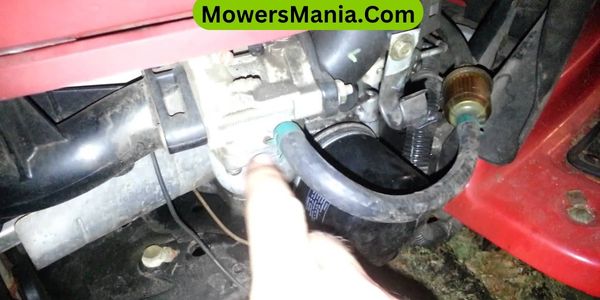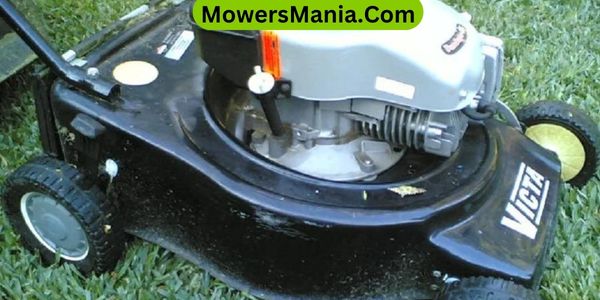If you’ve ever wondered how to drain gas from a lawn mower, you’re in the right place.
In this guide, you’ll learn the steps to safely remove fuel from your mower.
By following these simple instructions, you can keep your equipment running smoothly and avoid potential hazards.

So grab your tools and let’s get started!
Gather Necessary Tools and Materials
You will need a clean, empty gas can to safely drain the fuel from your lawn mower. Make sure the gas can is specifically designated for holding fuel and is free from any dirt or debris that could contaminate the gasoline in your mower.
Additionally, have a pair of safety gloves to protect your hands from any fuel spills and a funnel to ensure that the gasoline goes directly into the gas can without any spills or mess.
It’s also essential to have a wrench or pliers to loosen the fuel line and a rag to wipe up any drips or spills during the process.
Lastly, keep a well-ventilated area for the task and avoid draining the fuel near open flames or sources of heat.
Prepare the Lawn Mower
To prepare the lawn mower for draining gas, start by ensuring that it’s placed on a level surface and that the engine is turned off. This is crucial for safety and to prevent any accidental spills or leaks.
After this, here are a few important steps to emotionally prepare yourself for the task:
- Take a moment to appreciate the reliability and hard work your lawn mower has provided over the seasons. It has been a faithful companion in keeping your lawn neat and beautiful.
- Remind yourself of the satisfaction that comes with properly maintaining your equipment. A well-cared-for lawn mower ensures efficient performance when you’re ready to use it again.
- Reflect on the environmental impact of responsibly handling the gas. By draining it properly, you’re contributing to a cleaner and healthier environment for yourself and your community.
- Consider the sense of accomplishment that comes with successfully completing a maintenance task. Visualize the smooth process of draining the gas and feeling confident in your ability to care for your equipment.
Taking a moment to acknowledge these aspects can help motivate and prepare you for the task at hand.
Drain the Gas Tank

Using a siphon pump or a turkey baster, remove the gas from the tank, being mindful to avoid spilling.
To begin, place the siphon pump or turkey baster into the gas tank. If you’re using a siphon pump, follow the manufacturer’s instructions to create suction and start the flow of gas. If you’re using a turkey baster, squeeze the bulb to draw the gas into the baster.
Once the gas starts flowing, carefully direct it into a suitable container. Make sure the container is approved for gasoline storage and has enough capacity to hold all the gas from the lawn mower’s tank.
Keep a steady hand while transferring the gas to avoid spills and splashes. It’s important to work slowly and patiently to prevent any accidents.
Once all the gas is removed from the tank, securely seal the container to prevent any leakage or evaporation.
With the gas safely stored, you can proceed to the next steps in preparing your lawn mower for maintenance or storage.
Dispose of the Gas Properly
Once all the gas has been drained from the tank, securely seal the container and proceed to dispose of the gas properly. Proper disposal of gas is crucial for environmental and safety reasons.
Here’s what you need to do:
- Check with your local waste management facility for disposal options. This ensures that the gas is handled in an environmentally friendly manner.
- Never pour the gas down the drain or onto the ground. Doing so can contaminate the soil and water, posing a danger to the environment and wildlife.
- Consider recycling the gas if possible. Some facilities accept old gas for recycling or proper disposal.
- Store the sealed container in a safe and designated area until you can properly dispose of it. This will prevent any accidental spills or leaks.
Perform Safety Checks

After draining the gas from the lawn mower, carefully inspect the mower for any signs of leaks or damage before proceeding with any further maintenance.
Start by checking the fuel tank for any cracks, corrosion, or other damage. Ensure that the fuel tank cap is secure and not leaking.
Next, examine the fuel lines and connections for any wear, cracks, or loose fittings. Look closely at the carburetor and its connections to make sure there are no leaks or damage.
It’s crucial to also inspect the oil reservoir and the oil lines to ensure there are no leaks or signs of wear. Additionally, check the spark plug and its wire for any damage. Make sure the air filter is clean and in good condition, as a dirty or damaged air filter can affect the mower’s performance.
Frequently Asked Questions [FAQs]
Can I Use a Siphon Pump to Drain the Gas From My Lawn Mower?
Yes, you can use a siphon pump to drain the gas from your lawn mower. It’s a simple and effective way to remove the fuel. Just insert the pump and start siphoning.
Is It Safe to Keep the Drained Gas for Future Use in My Lawn Mower?
Yes, it’s safe to keep the drained gas for future use in your lawn mower if it’s clean and free from debris. Store it in a tightly sealed container and add a fuel stabilizer to prolong its shelf life.
How Often Should I Drain the Gas From My Lawn Mower?
You should drain the gas from your lawn mower at least once a season to prevent it from going stale. Regularly draining old gas and replacing it with fresh fuel helps maintain the engine’s performance.
What Should I Do if I Accidentally Spill Gas While Draining the Tank?
If you accidentally spill gas while draining the tank, immediately stop, wipe up the spill with a rag, and ensure proper ventilation. Avoid any open flames or sparks, and dispose of the rag safely.
Can I Use a Plastic Container to Dispose of the Drained Gas?
Yes, you can use a plastic container to dispose of the drained gas. However, ensure the container is approved for gasoline storage and disposal. Always follow local regulations for proper disposal of hazardous materials.
Conclusion
Now that you’ve successfully drained the gas from your lawn mower, you can rest assured that it’s ready for storage or maintenance.
Remember to dispose of the gas properly and perform safety checks before using the mower again.
With these simple steps, you can keep your lawn mower in good condition and ensure it runs smoothly in the future.



